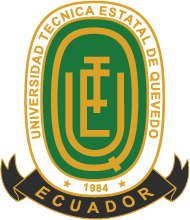Dynamics of the agricultural frontier of the zapotal hydrographic basin system through remote sensing tools
DOI:
https://doi.org/10.18779/cyt.v16i1.637Keywords:
geographic information system, agriculture, land useAbstract
Deforestation is one of the most critical problems facing humanity. Ecuador is one of the Latin American countries with the highest rate of forest clearing compared to its size, mainly due to the increase in agricultural area. The objective of this work was to determine the dynamics and changes that have occurred in the agricultural frontier in the last 30 years in the hydrographic basins belonging to the Zapotal using remote sensing tools. The images were obtained from the Sentinel 2 and Landsat satellites from 1990 to 2020. The free QGIS software was used to analyze, classify and process the satellite images; Through a confusion matrix and the kappa index, precision was evaluated. High quality and resolution satellite images corresponding to the period from 1990 to 2020 were obtained and processed. The Normalized Difference Vegetation Index (NDVI) allowed us to know the dynamics of the formation of the vegetation of the studied period and, consequently, the uses of the land. soil depending on the vegetation cover. The dynamics of the agricultural frontier, determined through the remote sensing tools used in this study, shows a decrease of approximately 15%. The methodology used in this study proved to be effective and economical to understand the dynamics of the agricultural frontier, which provides an effective tool to monitor, plan, and execute various territorial planning and local development projects.
Downloads
References
Almeida de Souza, A., Galvão, L. S., Korting, T. S., & Prieto, J. D. (2020). Dynamics of savanna clearing and land degradation in the newest agricultural frontier in Brazil. GIScience & Remote Sensing, 57(7), 965-984. https://doi.org/10.1080/15481603.2020.1835080
Congedo, L. (2021). Semi-Automatic Classification Plugin: A Python tool for the download and processing of remote sensing images in QGIS. Journal of Open Source Software, 6(64), 3172. https://doi.org/10.21105/joss.03172
Conrad, O., Bechtel, B., Bock, M., Dietrich, H., Fischer, E., Gerlitz, L., Wehberg, J., Wichmann, V., & Böhner, J. (2015). System for Automated Geoscientific Analyses (SAGA) v. 2.1.4. Geoscientific Model Development, 8(7), 1991-2007. https://doi.org/10.5194/gmd-8-1991-2015
Cui, L., Li, G., Ren, H., He, L., Liao, H., Ouyang, N., & Zhang, Y. (2014). Assessment of atmospheric correction methods for historical Landsat TM images in the coastal zone: A case study in Jiangsu, China. European Journal of Remote Sensing, 47(1), 701-716. https://doi.org/10.5721/EuJRS20144740
Drouet-Candel, A. E., Pérez-Castro, T., Cruz-La Paz, O. V., Drouet-Candel, A. E., Pérez-Castro, T., & Cruz-La Paz, O. V. (2021). Los sistemas de producción agrícola de las parroquias del norte de la provincia Santa Elena, Ecuador. Cultivos Tropicales, 42(4). http://scielo.sld.cu/scielo.php?script=sci_abstract&pid=S0258-59362021000400002&lng=es&nrm=iso&tlng=es
Dr.S.Santhosh, B., & M.Renuka, D. (2011). Geometric Correction in Recent High Resolution Satellite Imagery: A Case Study in Coimbatore, Tamil Nadu. International Journal of Computer Applications, 14(1), 32-37.
Hegazy, I. R., & Kaloop, M. R. (2015). Monitoring urban growth and land use change detection with GIS and remote sensing techniques in Daqahlia governorate Egypt. International Journal of Sustainable Built Environment, 4(1), 117-124. https://doi.org/10.1016/j.ijsbe.2015.02.005
Islam, K., Jashimuddin, M., Nath, B., & Nath, T. K. (2018). Land use classification and change detection by using multi-temporal remotely sensed imagery: The case of Chunati wildlife sanctuary, Bangladesh. The Egyptian Journal of Remote Sensing and Space Science, 21(1), 37-47. https://doi.org/10.1016/j.ejrs.2016.12.005
Karakus, C. B., Cerit, O., & Kavak, K. S. (2015). Determination of Land Use/Cover Changes and Land Use Potentials of Sivas City and its Surroundings Using Geographical Information Systems (GIS) and Remote Sensing (RS). Procedia Earth and Planetary Science, 15, 454-461. https://doi.org/10.1016/j.proeps.2015.08.040
Kaur, I., Kaur, P., & Verma, A. (2017). Natural Terrain Feature Identification using Integrated Approach of Cuckoo Search and Intelligent Water Drops Algorithm. International Journal of Computer Science and Information Security (IJCSIS), 15(2), 17.
Kumar, S., Shwetank, & Jain, K. (2020). A Multi-Temporal Landsat Data Analysis for Land-use/Land-cover Change in Haridwar Region using Remote Sensing Techniques. Procedia Computer Science, 171, 1184-1193. https://doi.org/10.1016/j.procs.2020.04.127
Li, J., Pei, Y., Zhao, S., Xiao, R., Sang, X., & Zhang, C. (2020). A Review of Remote Sensing for Environmental Monitoring in China. Remote Sensing, 12(7), Article 7. https://doi.org/10.3390/rs12071130
Liu, C., Chen, Z., Shao, Y., Chen, J., Hasi, T., & Pan, H. (2019). Research advances of SAR remote sensing for agriculture applications: A review. Journal of Integrative Agriculture, 18(3), 506-525. https://doi.org/10.1016/S2095-3119(18)62016-7
Cooray, P.L.I.G.M., Kodikara, K.A.S., Kumara, M.P., Jayasinghe, U.I., Madarasinghe, S.K., Dahdouh-Guebas, F., Gorman, D., Huxham, M., Jayatissa, L.P., 2021. Climate and intertidal zonation drive variability in the carbon stocks of Sri Lankan mangrove forests. Geoderma 389, 114929. http://dx.doi.org/10.1016/j.geoderma.2021.114929.
Lopes, V. C., Parente, L. L., Baumann, L. R. F., Miziara, F., & Ferreira, L. G. (2020). Land-use dynamics in a Brazilian agricultural frontier region, 1985-2017. Land Use Policy, 97, 104740. https://doi.org/10.1016/j.landusepol.2020.104740
López-Pérez, A., Martínez-Menes, M. R., & Fernández-Reynoso, D. S. (2015). Priorización de áreas de intervención mediante análisis morfométrico e índice de vegetación. Tecnología y ciencias del agua, 6(1), 121-137.
Memoria, R. Y. S. (1999). El fenómeno de El Niño 1997—1998. Memoria, retos y soluciones: Vol. Volumen IV: Ecuador. Corporación Andina de Fomento. https://scioteca.caf.com/bitstream/handle/123456789/675/Las%20lecciones%20de%20El%20Ni%C3%B1o.%20Ecuador.pdf?sequence=1&isAllowed=y
Merg, C., Petri, D., Bodoira, F., Nini, M., Díez, M. J. F., Schmindt, F., Montalva, R., Guzmán, L., Rodríguez, K., Blanco, F., & Selzer, F. (2011). Mapas digitales regionales de lluvias, índice estandarizado de precipitación e índice verde. Pilquen - Sección Agronomía, 11, 5.
Najafi, P., Navid, H., Feizizadeh, B., Eskandari, I., & Blaschke, T. (2019). Fuzzy Object-Based Image Analysis Methods Using Sentinel-2A and Landsat-8 Data to Map and Characterize Soil Surface Residue. Remote Sensing, 11(21), Article 21. https://doi.org/10.3390/rs11212583
Pang, G., Wang, X., & Yang, M. (2017). Using the NDVI to identify variations in, and responses of, vegetation to climate change on the Tibetan Plateau from 1982 to 2012. Quaternary International, 444, 87-96. https://doi.org/10.1016/j.quaint.2016.08.038
Panuju, D. R., Paull, D. J., & Griffin, A. L. (2020). Change Detection Techniques Based on Multispectral Images for Investigating Land Cover Dynamics. Remote Sensing, 12(11), Article 11. https://doi.org/10.3390/rs12111781
QGIS Development Team. (2022). QGIS Geographic Information System. Open Source Geospatial Foundation. http://qgis.osgeo.org
Rawat, J. S., Biswas, V., & Kumar, M. (2013). Changes in land use/cover using geospatial techniques: A case study of Ramnagar town area, district Nainital, Uttarakhand, India. The Egyptian Journal of Remote Sensing and Space Science, 16(1), 111-117. https://doi.org/10.1016/j.ejrs.2013.04.002
Semplades. (2013). Plan Nacional del Buen Vivir (Primera edición). https://siteal.iiep.unesco.org/sites/default/files/sit_accion_files/plan-nacional-para-el-buen-vivir-2013-2017.pdf
Serrano Vincenti, S., Reisancho Puetate, A., Borbor-Córdova, M. J., & Stewart-Ibarra, A. M. (2016). Análisis de inundaciones costeras por precipitaciones intensas, cambio climático y fenómeno de El Niño. Caso de estudio: Machala. La Granja, 24(2). https://doi.org/10.17163/lgr.n24.2016.04
Sierra, R. (2013). Patrones y factores de deforestación en el Ecuador continental, 1990-2010. Y un acercamiento a los próximos 10 años. Conservación Internacional Ecuador y Forest Trends.
Published
How to Cite
Issue
Section
License
Copyright (c) 2023 Yoansy García, Danilo Valdez, Daniel Mancero

This work is licensed under a Creative Commons Attribution-NonCommercial-ShareAlike 4.0 International License.
Licensing Agreement
This journal provides free access to its content through its website following the principle that making research available free of charge to the public supports a larger exchange of global knowledge.
Web content of the journal is distributed under a Attribution-NonCommercial-ShareAlike 4.0 International.
Authors may adopt other non-exclusive license agreements for the distribution of the version of the published work, provided that the initial publication in this journal is indicated. Authors are allowed and recommended to disseminate their work through the internet before and during the submission process, which can produce interesting exchanges and increase citations of the published work.












